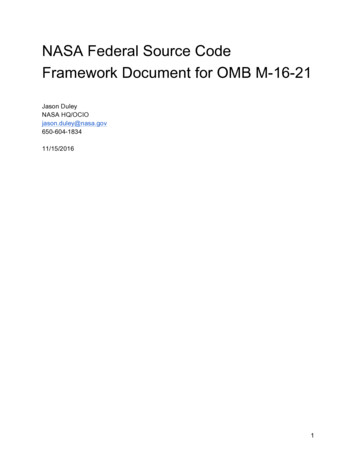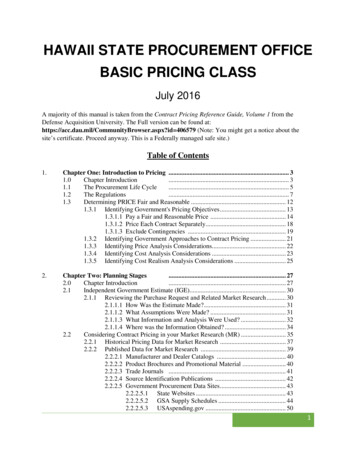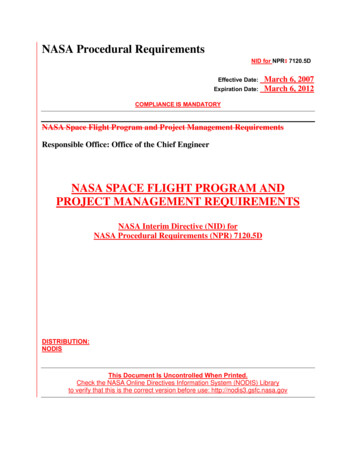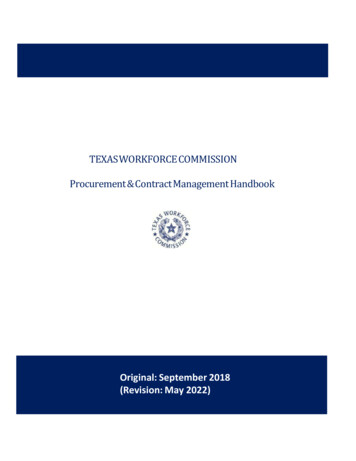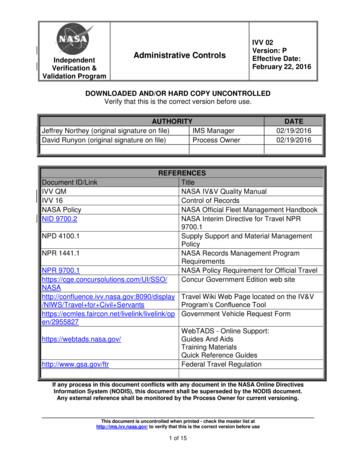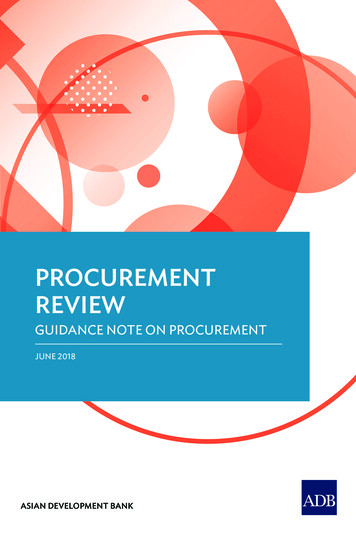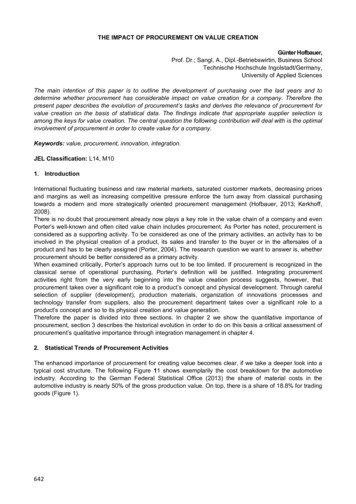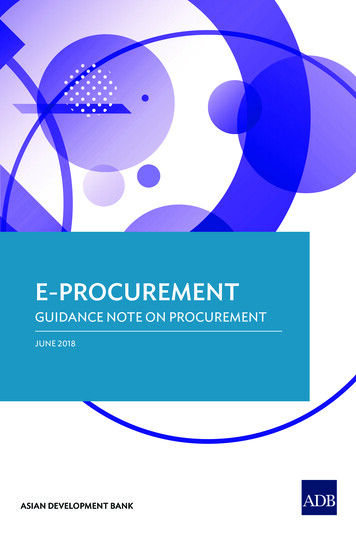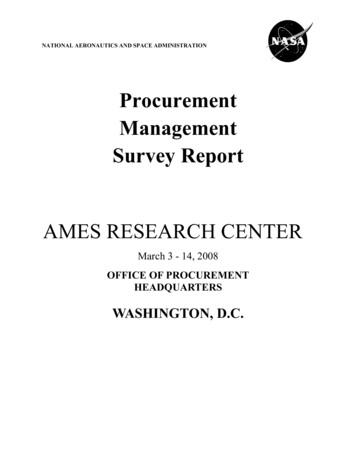
Transcription
NATIONAL AERONAUTICS AND SPACE ADMINISTRATIONProcurementManagementSurvey ReportAMES RESEARCH CENTERMarch 3 - 14, 2008OFFICE OF PROCUREMENTHEADQUARTERSWASHINGTON, D.C.
PREFACEThe NASA Headquarters Office of Procurement conducted the procurement management surveyat the Ames Research Center (Ames) under the authority of NASA Procedures and Guidelines1000.3, The NASA Organization. The survey was conducted from March 3 - 14, 2008. Thereport contains the survey strengths, weaknesses, and considerations.An exit briefing was held on March 14, 2008, to discuss the survey findings.This report serves as a basis, in part, for fulfilling internal control requirements in accordancewith the Federal Managers Financial Integrity Act of 1982 (P.L. 97-255).Ronald BackesSurvey Program ManagerOffice of ProcurementAnalysis Division2
CONTENTSSECTION I — OVERVIEW1. Survey Team Membership2. Survey SupportSECTION II — ORGANIZATION - MANAGEMENT1.2.3.4.5.6.7.8.Organizational Structure and StaffingPersonnel Interviews (Procurement, Legal, Technical, and Executive)Metrics Review and Documentation1102 Career Development and TrainingContracting Officer Technical Representative Training and DelegationSelf-Assessment ProgramInternal Policies and ProceduresContract Management Module IssuesSECTION III — PRE-AWARD PROCESSES AND DOCUMENTATION1.2.3.4.5.6.7.8.9.Master Buy Plan and Acquisition ForecastJustifications for Other than Full and Open Competition and Competition AdvocacyDeviations and WaiversAcquisition PlanningMarket ResearchPre- and Post-Negotiation MemorandaHomeland Security Policy Directive-12 ComplianceContractor Safety RequirementsContract Type SelectionSECTION IV — POST-AWARD PROCESSES AND DOCUMENTATION1. Synopsis of Contract Award2. Contractor Performance Evaluations NF-16803. Undefinitized Contract Actions4. Competition under Multiple Award and IDIQ Contracts5. Government Furnished Property6. Closeout/Unliquidated Obligations7. Award Fee and Incentive Fee Administration8. Contract Administration and Surveillance9. Exercise of Options10. Interagency Agreements11. Contracts for Administrative and Clerical Support12. Subcontract Consent3
SECTION V — PRICING/FINANCIAL/AUDITS1.2.3.4.DCAA Audit Follow-UpFinancial Management Reporting – NF-533sCost/Price Analysis and NF-634 Structured Fee Approach/Fee ObjectiveTechnical EvaluationsSECTION VI — GRANTS, COOPERATIVE AGREEMENTS, SIMPLIFIEDACQUISITIONS, AND OTHER ISSUES1.2.3.4.5.Grants and Cooperative AgreementsSimplified Acquisitions and Commercial Item ProcurementsPurchase Card ProgramConstruction and Architect Engineering Service ContractsEnvironmental IssuesATTACHMENT — SMALL BUSINESS PROGRAMSOVERVIEW1.2.3.4.5.Scope of ReviewOrganizational Structure and StaffingIndustry Assistance PrioritiesCenter Prime Contracting Socioeconomic Business GoalsCenter Subcontractor Socioeconomic Business GoalsPROGRAM MANAGEMENT1.2.3.4.5.Procurement PlanningSubcontracting PlanAward Fee/Incentive Fee ContractsSet-AsidesReportingOUTREACH1. Programs2. CounselingSUMMARY4
SECTION IOVERVIEWThe Ames Acquisition Division is providing meaningful support to their technical and programcustomers.The Procurement Management Survey consists of two primary components: 1) interviews withtechnical, procurement, legal, and Center executive personnel regarding the effectiveness of theacquisition division and 2) compliance reviews that consist of a review of contracting actionsfocused on adherence to procurement statutes, regulations, and procedures. The primaryemphasis of the compliance portion of the survey is on systemic procurement processes ratherthan individual file anomalies. Current procurement innovations, both Agency-wide and Centerspecific, are also reviewed.The results of both the interviews and compliance reviews are compiled into narrative summarieswith strengths, weaknesses, and areas of consideration identified as appropriate. Strengths aregenerally defined as best practices utilized in support of the procurement system. Weaknessesare defined as problems, typically systemic, that require corrective actions. Considerations aredefined as issues that 1) if not corrected could turn into a problem or problems that are notnecessarily systemic but should be corrected or 2) would result in better business practices ifcorrected.To promote the exchange of successful lessons learned and innovative procurementmethodologies between Centers, the team sought to identify Ames processes or initiatives thatmay be beneficial to other Centers and conversely sought to identify suggested approachesutilized by other Centers that may be beneficial to Ames.The exit conference at the conclusion of the survey typically consists of a direct exchange ofobservations and ideas between the participants. To emphasize Center ownership of theresolution of any identified weaknesses or considerations, the survey follow-up process willfocus on actions or initiatives undertaken by the Center to address survey findings. At anappropriate interval (approximately six months after this report is issued) the Ames ProcurementOfficer will brief the Assistant Administrator for Procurement and the survey team leader onCenter achievements in these areas.5
1. Survey Team MembershipBelow is a list of team members and the areas reviewed:Ron Backes, Survey Program Manager: Organizational Structure and Staffing, PersonnelInterviews (Legal, 1102, COTR, and Executive), 1102 Career Training and Development, SelfAssessment Program, CMMJoseph Bell, KSC: Deviations and Waivers, Synopsis of Contract Award, Contracts forAdministrative and Clerical Support, Construction and A&E Service ContractsPatrick Flynn, HQ: COTR Training and Delegation, Market Research, Subcontract Consent,Environmental IssuesDon Moses, HQ: DCAA Audit Follow-Up, Master Buy Plan Actions, HSPD-12 Compliance,Competition under Multiple Award and IDIQ contracts, Exercise of OptionsBrad Poston, HQ: Metrics Review and Documentation, Internal Policies and Procedures,Acquisition PlanningTom Russell, GSFC: Undefinitized Contract Actions, Closeout/Unliquidated Obligations,Justification for Other Than Full and Open, Competition, Contractor Performance EvaluationsNF-1680, Interagency Agreements, Financial Management Reporting - NF-533sRebecca Wilkinson, JPL/NMO: Contract Type Selection, Award Fee and Incentive FeeAdministration, Grants and Cooperative Agreements, Purchase Card Program, PersonnelInterviews (Legal, 1102, COTR, and Executive)Cheryll Williams, JPL/NMO: Pre- and Post-Negotiation Memoranda, Cost/Price Analysis andNF-634 Structured Fee Approach, Technical EvaluationsDavid Grove, OSBP: Small Business ProgramsIn addition, the NASA Office of Safety and Mission Assurance participated in the AmesProcurement Survey in the following areas:Chuck Halloway, Honeywell: Contract Administration and SurveillanceMaurice Paulson, Honeywell: Contractor Safety RequirementsRay Hill, Honeywell: Government Furnished Property6
2. Survey SupportThe survey could not have been accomplished successfully without the support of the followingindividuals:Jill Willard, Ames Point of ContactSue King, Ames Point of Contact7
SECTION IIORGANIZATION - MANAGEMENT1. Organizational Structure and StaffingThe Ames Acquisition Division reorganized on April 1, 2007, in an effort to provide a leanermanagement structure to focus resources on production. The Division consists of three branches:the Acquisition Business and Operations Branch, the Programs and Projects Branch, and theMission Support Branch. The Acquisition Business and Operations Branch is responsible for: division policy;requirements;procurement business systems;reporting;self-assessment and internal controls;small business coordination;purchase card management;training;cost and pricing and external audit tracking;Freedom of Information Act requests;contract closeout;Source Evaluation Board facilities and operations; andtravelThe Mission Support Branch is responsible for: institutional support;facility operations; andon-site Research and DevelopmentThe Programs and Projects Branch is responsible for: Ames Programs and Projects;Aeronautics;rotorcraft research and development;small spacecraft;grants and cooperative agreement administration; andCenter specific awards, such as NASA AstrobiologyThe Acquisition Division was reorganized in April 2007. Three operational branches wereconsolidated into two. Workload is now assigned by function, and branch chiefs are responsiblefor working with customers to develop acquisition strategies. The reorganization was done torebalance workload, to standardize the group lead role across the division, and to use small teams8
led by senior contract specialists. This approach ensures that junior personnel are effectivelycoached and mentored. The approach also facilitates effective workload management, qualitycontrol, and back up of capabilities across the organization. The structure provides flexibility fordevelopmental rotations to enhance the depth of experience across the organization. Thereorganized structure incorporates a procurement control unit through which PRs are submittedto the Acquisition Division. This single point of entry for PR submission enhances the quality ofdocuments submitted to the Acquisition Division.The Acquisition Division consists of 53 employees. The staff includes 45 Full Time Permanentemployees, one Term employee, two Federal Career Interns, and five COOP students. Thisrepresents a reduction of four Full Time Permanent employees since the previous survey in 2005.Of the 53 employees on-board, 40 employees are in the 1102 Contract and Acquisition careerseries, 31 employees hold contracting officer warrants, 12 employees, or 23 percent of theAcquisition Division workforce, are currently eligible to retire.Several initiatives are in progress in the Ames Acquisition Division. These initiatives are drivenby external reviews and audits as well as an internal “Tiger Team” review of the procurementprocess. Initiatives include integration of procurement process with other key Center processesin accordance with the AS9100 Aerospace standard, invigoration of the self-assessment process,and an Acquisition Division Climate Survey. In addition to the initiatives in progress, a numberof initiatives are projected for the near and longer terms. Near-term initiatives include monthlyworkload reviews, standardization of lead times, concurrent file reviews, training, guidelines onexpectations for promotions, mentoring, and employee recognition. Longer term initiativesinclude an effort to streamline policies and provide standard templates, Individual DevelopmentPlans, and situational leadership. The Division also plans to focus on key areas of procurement,including Justification for Other than Full and Open Competition (JOFOCs), UndefinitizedContract Actions (UCAs), Performance Evaluations, Pricing (including task orders), and Metrics.STRENGTH:The Ames Acquisition Division is commended for taking a proactive and comprehensiveapproach to tackling challenges in the current acquisition environment and forimplementing a plan to improve critical areas.CONSIDERATIONS:1. The Ames Acquisition Division should consider mandating the use of milestonetemplates within CMM to facilitate the tracking of lead times.2. The Ames Acquisition Division should work with the Headquarters Office ofProcurement and the Ames Head of the Contracting Activity to develop a recruiting,retention, and staffing plan to ensure that procurement requirements for the Centerwill be met in the foreseeable future.9
2. Personnel InterviewsProcurement StaffInterviews were conducted with a wide range of individuals in the Acquisition Division, varyingfrom the most junior levels to senior personnel with more than 20 years of procurementexperience. All grades were represented in the sample. Responsibilities ranged from Researchand Development contracts and agreements, simplified acquisitions, and institutional services toco-located support for Ames programs and projects. Some individuals interviewed had limitedexperience with Government contracting but were assigned fairly complex work. The processesfor reviewing the work of these less experienced individuals is critical to ensuring the division’ssuccess; however, the level of review was not consistent across the division. A significantchallenge noted during the interviews is the pressures of a significant workload limiting the timefor more experienced personnel to conduct thorough reviews. Several senior personnelexpressed frustration at having to do work themselves, rather than being able to train neweremployees how to do it.Communication is reported as generally good. Some of the Acquisition Division’s leadership isreported as providing good communication. Others in leadership position are reported asneeding improvement in this area. There is a sense of collaboration in the organization that mayhave been lacking in the past; however, several employees report that knowledge sharing acrossbranches is not effective. The recent reorganization has facilitated more cross-branchcommunication. The concurrent review process recently initiated facilitates inter-organizationalcommunications, and periodic round tables are reported as a positive trend at encouragingknowledge sharing among Acquisition Division employees. There is a perception of poorcommunications and of a negative image of procurement from Center leadership.Customer relations are reported as good to great. There is a mutual appreciation of pressures,and the procurement organization and technical customers work well together to succeed. Thereis a sense that the Acquisition Division is taking proactive steps to manage customerexpectations by establishing and communicating milestone schedules for various types ofprocurement actions. This is a necessary step to help the technical customers plan for theirprojects’ success.Relations with attorney-advisors vary depending on the individual. Some reported highlypositive experiences such as early involvement with legal and a sense of belonging to a team.Others expressed concern at attorneys not being willing to engage in dialogue on issues, butinsisting that the individuals work within their organization to get answers.Training is perceived as strongly supported by division leadership and meaningful when madeavailable. Funding constraints are cited as reasons for non-availability of courses beyond theformal contracting curriculum. Workload pressures inhibit many employees from takingadvantage of training opportunities. Others feel they are at a point in their career when trainingis not as important as it had been earlier in their career. Round table sessions presented by theAcquisition Business and Operations Branch and informal training sessions are seen as positiveand effective when available. Some junior employees report difficulty getting classes. Several10
employees suggested that courses offered locally might result in higher attendance than coursesat the NASA Management Development Center at Wallops Island, Virginia, and have the addedbenefit of increasing the camaraderie across the division. Most employees reported having anIndividual Development Plan.Management feedback is generally perceived as good, both in day-to-day performance and inperiodic performance reviews. Awards and recognition are good, but there is a sense that morefunding could be made available for this. Management is seen as largely supportive, providingmentorship and supporting individual employees and their families. There were a limitednumber of exceptions to this general perception, attributed to a need for better communicationskills for some at the branch level. Several recommended that the Acquisition Divisionleadership take management and leadership courses to improve in this area.Several employees expressed appreciation for their colleagues, including Joanne Comstock forher dedication in the policy arena, Gary Heagy for his open and approachable style, Pat Hudsonfor her tireless support for all with CMM, and Kelley Kaplan and Ronnee Gonzales for theirsupport mentoring other employees. There is a sense of cautious optimism for the new divisionleadership, with a sense that things have “turned a corner.”The majority of personnel interviewed report high levels of involvement with their customersand a sense of being “part of the team.” Involvement with programs, projects, and institutionalcustomers varies from area to area. Co-located employees report high levels of involvement.Individuals in Mission Support areas report challenges at engaging their customers in a timelyand meaningful way.Communications with the Headquarters Office of Procurement are generally good. Severalemployees expressed a sense that there are some barriers to communications, that employeesshould work issues within their teams and branches before contacting Headquarters. Manyexpressed positive experiences with Headquarters analysts, including Don Moses, JamielCommodore, Diane Frazier, and Brad Poston. There is a sense of frustration among a smallnumber of interviewees that Headquarters personnel have a tendency to ask for informationwithout being clear on what is needed but are critical of the information submitted.Several suggestions were made that the Acquisition Division take a serious look at recruitmentand retention. There is a sense that there have not been enough new hires to fill the shoes ofpending retirees. A suggestion was made to leverage interns and CO-OP students to attendcareer fairs and interest other students in working for the Ames Acquisition Division.Technical CustomersRepresentatives from a variety of technical organizations were interviewed regarding theeffectiveness of and their level of satisfaction with the Ames Acquisition Division. Intervieweesrepresented various programs and projects at Ames and Headquarters, from mission supportorganizations to major projects. They included individuals with a few years’ experience to thosewith over 30 years experience at Ames. The relationship with the Acquisition Division rangesfrom “very good” to “great.” Procurement personnel were reported as generally finding ways to11
“make things happen rather than throw up roadblocks.” Several reported frustration with theprocess for less visible Information Technology or other “routine” types of contract actions.These actions were perceived as laden with red tape and lacking good customer service. Severalexpressed a need for better coverage when a contracting officer is out of the office, for a back-upin case a key decision or award needs to be made.Some interviewees expressed the concern that the loss of senior procurement personnel haseroded the experience base and that the staff has not increased sufficiently to allow the divisionto recruit and train new personnel. There is also a concern about the organization’s ability toaccurately assess the capabilities of newer employees and to assign them work appropriate totheir capabilities. Management focus on quality appears to be slipping. Several customersexpressed frustration with the business systems in the Acquisition Division, specifically CMMand the Integrated Enterprise Management System (IEMP). Glitches in these systems haveimpacted the timeliness of procurement actions and in several cases resulted in lost funding.There is a sense among technical customers that the division has overcome the initial learningcurve and is returning to a more consistent level of performance. In spite of these significantchallenges, technical customers report that their contracting officers do really good jobs and thatthey have come through for them time and again.Contracting Officer Technical Representative (COTR) training is reported as generally effective.Several suggest that refresher training should be more frequent than five years but that it shouldfocus on recent changes in the field rather than rehashing material covered in the basic course.Several expressed a preference for online refresher training.Electronic interfaces are perceived as antiquated. Suggestions for improvement included theautomation of contract documents such as contracts, task orders, and data deliverables. Theseare currently kept in folders on hard drives and tracked with excel spreadsheets. A commondatabase for contracting officers, COTRs, contractors, and task managers with appropriatesecurity and safeguards would enhance productivity. Customers reported that there is muchroom for improvement in the current procurement business systems from their perspective. Thesystems should take advantage of workflows, include PKI Certification for secure transactionsand should automate the process from start to finish. Customers said there is no reason to usepaper contract files and suggested these should be electronic and include the use of electronicsignatures.Technical customers offered many kudos for specialists and contracting officers they workedwith. One interviewee captured the sentiment by saying, “They all deserve kudos . theAcquisition Division really is a good group of people once you get to know them.”Legal OfficeThe survey team conducted interviews with representatives from the Ames Office of ChiefCounsel. Procurement personnel involve their legal advisors early in the acquisition planningprocess. During contract administration; however, there is a tendency not to involve legalcounsel until after problems arise. Several attorneys expressed frustration with the timing ofpolicy changes that impact the Source Selection language. The change has come at a bad time12
for Ames which is experiencing a relatively large number of source evaluation boards. Theinterviewees expressed the sentiment that Agency standard language for sections L and M wouldbe helpful in managing these changes.The quality of procurement work products were reported as having declined over the past five tosix years, but this assessment was highly dependent on the individual specialist or contractingofficer who did the work. There is a perceived need for increased mentoring and file review forless experienced employees. The lack of resources inhibits effective review and mentoring.Several interviewees expressed that management reviews have declined in quality, thatfundamental errors are reaching the legal office without adequate review by Acquisition Divisionmanagement. The legal review threshold of 2.5 million is perceived as relatively high but, evenat this level, documents are arriving without effective management review. Justifications forOther than Full and Open Competition and Grants are not reviewed by legal.Procurement personnel are seen as understanding their business in terms of acquisitionregulations and procedures but are less effective at managing customer expectations.Inconsistent guidance and management support from the Headquarters Office of Procurement,Center, and Acquisition Division leadership is seen as problematic. Similar to findings on theprevious survey, the legal community believes that this situation puts working level contractingofficers in a difficult position when it comes to ensuring appropriate contract practices arefollowed by their technical customers. Unclear guidance, inconsistent interpretation of existingguidance, and a perceived unwillingness of management to support contracting officers inhibitsthe ability of the contracting officer to exercise sound business judgment when faced withquestionable requests made by technical customers.The legal community reports a high level of results-driven pressure on the Acquisition Division.They report that morale appears low, that people seem overworked, and that procurementpersonnel feel like they are not respected by other organizations. The legal office reported thatthere are talented people in the Acquisition Division, from the front-line operations through thebranches and back office. There is a sense that procurement personnel need to be energized, topull up the division to where it should be.ExecutiveThe survey team interviewed several executives at Ames Research Center, including missionsupport organizations and project offices. Interviewees had experience at Ames ranging from 1year to more than 20 years. The perception of the Acquisition Division varied dramatically from“totally broken” to “hard working” and “responsive.” Frustration stemmed from a lack oftransparency in the procurement process, expressed as the inability to see the progress ofrequirements as they move through the procurement process. Other concerns included acumbersome Award Fee process and untimely payments as well as inconsistent involvement byprocurement personnel in projects. There is a reluctance to provide negative feedback tocontractors. Instead, there is a preference to use rewards as a carrot rather than highlight orexpose negative performance.13
The procurement community is perceived as risk averse rather than proactive and helpful. Thereis a clear recognition that the staffing level in the Acquisition Division is insufficient toaccomplish the mission of Ames. Individuals are conscientious and hard working, but thepersistent overtime and stress has impacted their ability to delivery quality service. Somecustomers feel that they do the work and hand it off to procurement to obligate the funding. Theinvolvement of mid-level management seems to have diminished over time and service levels areuneven. Generally, the executives believe that the Acquisition Division is staffed with aknowledgeable and talented workforce dedicated to delivering its best, but day-to-day pressuresseem to inhibit their capacity. Automation of key processes and insight into critical processeswithin Acquisition would help establish more realistic customer expectations. The ability to login to a system to get information on the status of procurement requests would alleviate anxietyabout the process and relive pressure on the procurement staff. A recent milestone schedule forupcoming projects communicated by the Procurement Officer was seen as a positive measure tohelp projects plan effectively for their procurement activities.3. Metrics Review and DocumentationThe FY 2005 survey noted that the staffing for this function had been reduced and that metricswere not being produced on a consistent basis. The current staffing situation is somewhatimproved; however, neither the staffing nor the metrics reporting is optimal.The Ames Acquisition Division collects and provides metrics to support the NASA AnnualProcurement Report, Undefinitized Contract Actions (UCA) report, and Subcontracting report.Routine use of reporting from SAP is used to track the status of procurement requests andmonitor Unliquidated Obligations (ULO). Reports available through the purchase card systemare used routinely to monitor performance and identify areas for further review.The Ames Acquisition Division also makes effective use of more subjective metrics, such as asurvey of all Source Evaluation Board and Source Evaluation Committee members upon theconclusion of boards. In addition to measuring performance, this tool facilitates the learningprocess so that adjustments can be made to improve organizational performance. The AmesAcquisition Division has a long standing practice of monthly roundtables which is a combinationof training session and feedback tool for the procurement community.However, the Ames Acquisition Division recognizes that there are a numbers of other metrics,such as award fee, work load, and customer satisfaction that should be collected to measure theirperformance and organizational health. The recent Climate Survey and regular meetings withsenior Center management are seen as positive first steps towards addressing organizationalhealth. The Acquisition Business and Operations Branch (JAB) draft of JA.0001, a policydesigned to address this area, reflects well on the planning for more structured andcomprehensive metrics in the future. The effort to use the tools other Centers have alreadydeveloped is also a sound, effective approach to future improvements in collecting meaningfulmetrics.14
CONSIDERATION:The Ames Acquisition Division should develop and coordinate with appropriatestakeholders a complete set of relevant metrics to monitor and assess the efficiency andeffectiveness of their performance and the overall health of the organization.4. 1102 Career Development and TrainingThe survey team reviewed the Ames Acquisition Division’s local policies and procedures relatedto 1102 training and development. The review consisted of interviews with responsiblepersonnel, a review of training records, and an assessment of the effectiveness of theimplementation of the Federal Acquisition Certification in Contracting (FAC-C).The Ames Acquisition Division issued Acquisition Alert Number 08-02, “Training: FAC-CProcess,” on December 12, 2007. The alert notified employees about changes to NASAprocurement training policies and the issuance of the NASA Procurement Career Developmentand Training Policy Handbook. The alert included links to the Handbook and the FAC-CApplication and instructions, outlined the local procedures for completing and submitting theFAC-C applications, and provided common questions and answers regarding the process. Thetraining coordinator maintains an excel spreadsheet identifying the status of employees’ warrantsand FAC-C certification information. This information is periodically updated and is used tonotify employees about upcoming courses for required certification.The training coordinator maintains records of employees’ FAC-C applications and supportingdocumentation. Supporting documentation includes the FAC-C application checklist, coursecertificates, FAC-C and Defense Acquisition Workforce Improvement Act (DAWIA)certifications, college transcripts, and notes concerning the review and approval of applicat
The NASA Headquarters Office of Procurement conducted the procurement management survey at the Ames Research Center (Ames) under the authority of NASA Procedures and Guidelines
